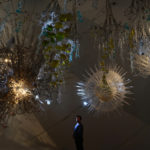Aegis / Noosphere
Transforming Space
Toronto, CAN - 2018
Transforming Space is composed of two sculptural works — Aegis and Noosphere — in addition to the couture Aeriform dress created by Beesley and his long-time collaborator, the fashion designer Iris van Herpen. “To me this dress is…an expression of the way Philip inspired me to rethink the relationship between our body and the space around us, to remodel the relation between our insides and our outsides,” says Van Herpen. The cloud-like garment composed of laser-cut, hand-molded metal lace was commissioned by the ROM and developed for Paris Couture Week in 2017.
Framing the Aeriform dress and Van Herpen’s retrospective are two sculptural test-bed environments that combine synthetic biology, artificial intelligence, mechanics, sound, light, and filtering systems. The first ‘living lab’ Aegis is named for the fertile veil from ancient Greek myth that protects and shelters all life. This sculptural canopy that cradles the Aeriform dress is composed of a matrix of responsive fronds that cover an innovative flexible structural mesh embedded with artificial intelligence. As the mylar fronds gently stir the air, they activate microprocessors and sensors organized in dense meshes that can learn, adapt, and even show curiosity as they evolve. The artificial intelligence in the sculpture is programmed with a curiosity-based algorithm causing the system to constantly search and find new patterns of behaviour. At the centre of this intricate web is a constantly-changing and evolving intelligent soundscape developed with the sound designer Salvador Breed and 4DSOUND.
Alongside the canopy, the delicate steel and acrylic skeletal mesh of the spherical volumes comprising Noosphere house vessels containing prototype cells that display certain life-like properties. Combinations of oil, inorganic chemicals, and water-based solutions stimulated by LED lights, create chemical skins within these cells that might lead to new kinds of self-renewing skins for future buildings. The structural mesh of the sculpture uses overlapping strands within conical stem-shaped cells that possess extraordinary strength using minimal amounts of material.
Further collaborators include University of Waterloo researchers, engineer lead Professor Rob Gorbet, Professor Dana Kulić, and the Living Architecture Systems Studio.











